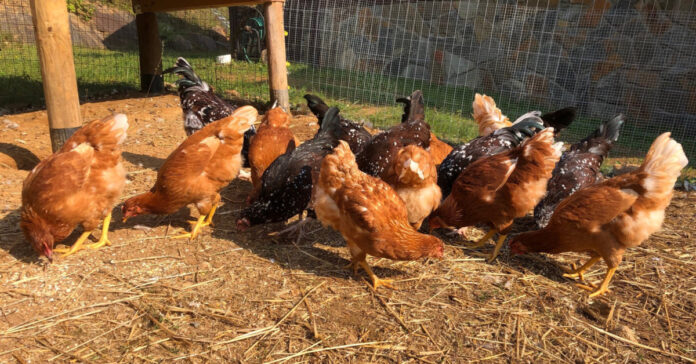Last week, my daughter complained about paying $5.89 cents for a dozen eggs, or about 50 percent per egg. That’s up from $1.39 a year ago. I told her to be happy they were not sold out.
We joked about how many free eggs she would have to get from us to pay for a trip here, but our chickens aren’t producing that much because of the winter, so it was a moot point. The egg numbers are up, however, with the chickens are laying five eggs per day now instead of two or three. That bodes well for the future. As the days grow longer, they should lay even more.
I just bought eight chicks for about $4.50 each. They will arrive in April and start laying in September. I estimate it will take about $100 worth of feed over that time. So starting in September, I’m going to get six to eight additional eggs per day. For the next year, I will get eggs for about 11 cents each. If I amortize that $150 upfront cost, the cost then it drives the cost up to 17 cents per egg for the first year.
You can do the same thing, assuming you already have a chicken coop. If you don’t, you can buy or build a chicken coop for a few hundred dollars more. If you sell your eggs, then you’ll recover some of that investment.
Unfortunately, my daughter lives in a rented house without a fenced yard, so she can’t raise her own chickens. If you are in a similar position, my advice is to make friends with someone who raises chickens and hope they give you some eggs. We’re still selling ours for $5 per dozen, although we may increase that this summer.
Bird Flu
Avian Influenza H5N1 is taking much of the blame for the increased cost of eggs. In the past year, more than 57 million birds have been culled in the U.S., including 44 million laying hens. If we do the math, that’s 44 million eggs that were not produced every day for the five months it took for the replacement chicken to go from chick to egg layer. If a chicken lays one egg per day, that works out to 6.6 billion eggs that are missing from the supply chain. That sounds like a huge number, but if you divide by 330 million Americans, that is just 20 eggs per person.
The same article says that egg production is down 7.5 percent on average. That means we consume over 80 trillion eggs in the U.S. per year. That’s not just breakfast, but in backed goods and prepared foods.
Statista estimated the annual egg consumption in 2022 was 287 eggs per person. That equals 95 trillion eggs. If we are down 7.5 percent, that would be about 7.1 trillion eggs. That works out to be 22 eggs per person. Close enough to our original estimate of 20 eggs.
Something Doesn’t Add Up
Hmm. That doesn’t seem like enough to create empty shelves and drive up the prices by 500 percent. The math doesn’t add up. Something else must be going on around here.
It’s not exports, however. Statista says we exported 334 million eggs in 2019. That’s just one egg per person, not enough to make a difference.
Are the chickens quiet quitting? No, but maybe the farmers are. I expect some large-scale commercial egg producers are cutting back because of the rising cost of feed. Maybe some are going out of business because of inflation. Perhaps the farmers they are tired of seeing prices in the grocery store quadruple while their compensation isn’t growing at an equal rate. Maybe some farmers shut down a few hen houses over the winter because of the high cost of propane required to heat them.
Is bird flu a contributing factor? Yes. Is it the only factor? I don’t see how it could be. It’s not like they are being freeze dried and sold to preppers. My guess is we’ll never know for sure, but someone or something appears to be manipulating the market.
Staple Foods
Eggs used to be inexpensive. I remember when they were 79 cents per dozen. They were less than $1 per dozen as recently as 2000. They were an excellent source of protein at a very reasonable price. Unfortunately, that’s no longer the case.
Other staple foods, like bread, are also getting more expensive. Milk is shockingly expensive. Chicken meat, which until 2020 could be found for 99 cents per pound or less for legs and thighs, has also shot up. That’s being blamed on bird flu, too.
Make me wonder if there is truth to the theory that climate change proponents are trying to get us all to eat less meat.
Strive for Self Sufficiency
The lesson here is to be as self-sufficient regarding food as you can. It will benefit you now and may be your only choice after the SHTF. Here are some basic suggestions:
- Raising chickens for eggs is easy and does not require much land. I spend less than 15 minutes a day on mine. Many municipalities allow you to raise 6 chickens as long as you don’t have a rooster. You can also raise meet birds.
- If you have the land, consider producing your own dairy with a milk cow or goat. That allows you to make cheese, yogurt, cream, and many other dairy products, significantly lowering your grocery bill. You can also generate some of your own meat.
- Rabbits are also an excellent source of meat and can also be kept in rural or suburban areas.
- Sheep are also another source of meat, and I have heard some say they are less trouble than goats. If you don’t want to shear them for wool, consider Hair Sheep, which have hair, not wool.
- Whether you raise cows, goats, rabbits or sheep, their hides have value, too.
- Don’t forget to garden. If you have the space and the time and energy, you can produce large amounts of food in a traditional row garden to consume fresh and put up for the winter. If you have time or space constraints, consider raised beds or even a container garden. Every little bit will help.








